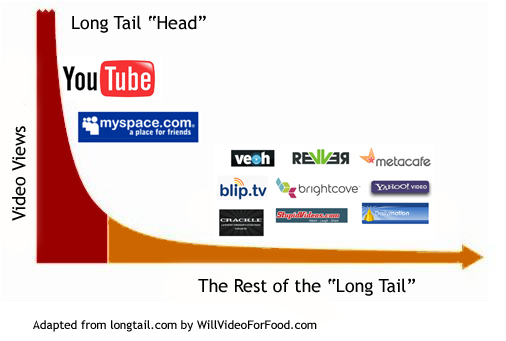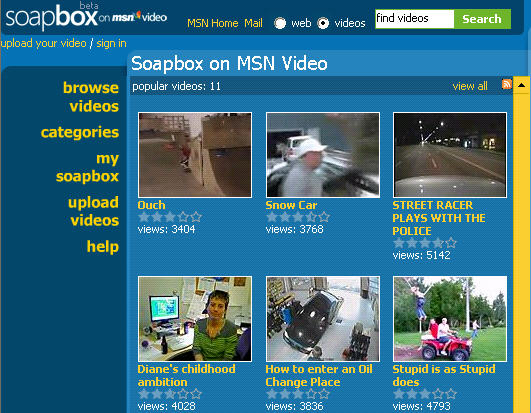Want to get your stuff seen? Should you obsess with YouTube or go for the “long tail“? Let’s explore this important debate, and obviously the right answer is “do both.” But don’t hold your breath waiting for a million views on YouTube, or kill yourself getting your video on the homepage of some niche blog that gets 20 visitors a day.
 When you look at the share of online videos by comparing various major players, you’ll find YouTube dominates — whether you’re measuring via ComScore’s roughly 1 million panel or Hitwise’s 25 millionish data via internet service providers). YouTube’s slice can vary, depending on your data source and how you define the pie (for instance, including MySpace or not).
When you look at the share of online videos by comparing various major players, you’ll find YouTube dominates — whether you’re measuring via ComScore’s roughly 1 million panel or Hitwise’s 25 millionish data via internet service providers). YouTube’s slice can vary, depending on your data source and how you define the pie (for instance, including MySpace or not).
Although YouTube is indisputably the biggest with more views than the next several largest sites combined, this recent press release by ComScore puts things in perspective. Although more than 90 percent of my average video views occur on YouTube, that’s not representative.
Together we all viewed 9 billion videos online in September. But only 2.6 million of those were seen by 70 million people via Google/YouTube (representing 28.3%). (Note that more than 38 million people viewed approximately 360 million videos on MySpace.com, yet MySpace TV accounted for 766,000 viewers and 1.1 million videos. But aren’t some of these YouTube videos?).
When you’re looking at pure-play online video sites, the cliff drops sharply after that. Just 4 percent for Yahoo and 4 percent for Fox. Then the other major networks are in the low single digits.
So here’s the interesting thing. Only about 50% of the views are coming from the top 10 sites. That means the rest of the industry is hyper fragmented… aka the “long tail” of video.
Pandemic Labs (a “revolutionary marketing agency”) has a blog that criticized my recent AdAge article’s statement: “The vast majority of online viewing occurs on YouTube. Putting your videos on a bloated-product.com site is the online equivalent to running television commercials on a kiosk hidden in an abandoned cemetery.”
Says the blog: (Nalts) is unfairly sidelining some very powerful sites and not taking into account the power of viewer targeting which is crucial to viral success for marketers. The wording of this lesson accidentally makes it seem like YouTube is the only site worth seeding a video on, even though that is probably not what he meant to imply. Pandemic Labs has a network of over 50 sites that we use to seed videos. We don’t use all of these sites for every campaign, but it is critical to the spread and success of viral videos to reach specific target audiences on larger sites such as Break, Metacafe, and Kontraband, all the way down to small sites like SuperDeluxe, JibJab, and Dorks.com.
 Fair criticism- don’t forget the long tail. While I don’t advocate trying to create a new video destination if you’re a brand trying to market (fish where the fish are), it is worth remembering that a viral-video marketing campaign is bigger than putting all your eggs in the YouTube basket.
Fair criticism- don’t forget the long tail. While I don’t advocate trying to create a new video destination if you’re a brand trying to market (fish where the fish are), it is worth remembering that a viral-video marketing campaign is bigger than putting all your eggs in the YouTube basket.
Bottom line for you “scanners”: There’s a lot of viewing taking place on smaller video sites and blogs, and it’s much easier to get featured on them. More importantly, you’re now targeting. Para exampl  a view of my video for Holiday Inn Express is worth far more on travel sites than YouTube. Just don’t under estimate the labor associated with getting quantity of views on smaller properties, and watch that “point of diminishing returns” very closely.










